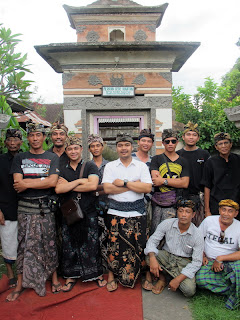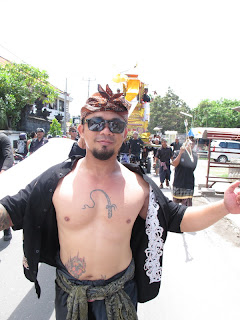Last month I finally got to sit at Sultan Agung’s feet — albeit 500 years too late.
Sultan Agung, the Mataram dynasty’s greatest ruler — who united nearly all of Java and actively resisted Dutch colonial rule throughout his reign — built the royal tombs at Imogiri in 1645. The magnificent complex — once a terraced sanctuary for the worship of ancestor spirits in ancient times — sits on top of a hill at Imogiri, 25 kilometres south of Jogjakarta. The tombs are closed to the public on most days and photography is strictly prohibited inside when the terraces are open; I had fortunately invited an artist friend, Peter Kingston, from Sydney, Australia who captured, exquisitely, the atmosphere of devout tahlilan Muslim prayers (see drawing opposite).
My group of 25 arrived at 9 a.m. on Sunday
24th March and were quickly outfitted in formal Javanese court attire
in the low-eaved pavilions of the tomb complex’s forecourt — bold
patterned batik skirt-cloths and blue and black swargan
shirts for men, batik wraps for ladies. The architecture of the
complex is hauntingly Hindu: Imogiri was given an Islam-Majapahit
‘make over’ during the early 17th century when it was chosen by Sultan
Agung as final resting place for the rulers of the numerous palaces of
Jogjakarta and Solo — the two ‘palace cities’ of Central Java. The
custodians of the tombs are Hamengku Buwono and Pakubuwono palace staff
who maintain the terraces and the tombs with great care: they are also
all fonts of wisdom about Javanese court life and culture. We were
also lucky to witness the ritual cleansing of the famous sultan’s
heirlooms — his kris knives and swords — outside the handsome cungkup pavilion which houses the tombs of the sultan, his son and his queen.
After exploring some of the many
courtyards of the complex we climbed out of Javanese dress (Rp. 15,000
rental) and returned home via the bus terminal below for a plate of Nasi Pecel Imogiri, the spicy peanut sauce and rice dish for which the area is renowned.
• • •
By one p.m. we were back at the delightful d’Omah hotel in Tembi — where a Jatilan
trance dance was in progress in a special bamboo enclosure that had
been constructed by our host, Sir Warwick Purser, in the garden. There
were three sessions — pre-teens, teens and adults — taking turns to
burn up the arena with graceful dancing and colourful trance antics. The
lead singer, a siren from nearby Bandung village, is definitely
Central Java’s answer to Rihanna
(see my video: Jatilan at d’Omah http://www.youtube.com/watch?v=e8CLybfYLNI ).
The next day my group went to Borobudur
and, afterwards, to the amazing Amanjiwa hotel for lunch. It’s almost 20
years since Ed Tuttle designed the hotel and Bill Dalton did the
gardens and it’s never looked better. Two hotel staff members were
playing an Eric Satie version of Javanese court music in the elegant
restaurant which overlooks the temple. Peter Kingston was in an
euphoric mood showing off his sketches from his morning on the man-made
mountain.
“It’s a temple of details,” he confessed.
• • •
The next day we went to Solo for a court Srimpi Ganda Kusuma
dance performed at Ndalem Harjonegaran, the former home of batik
impresario and Javanese historian Harjonegara Go Tik Swan, the ultimate
Javanese aesthete who died a few years ago. The house has a special kris
foundry in a back courtyard, modelled on one depicted on a 16th
century relief at Candi Ceto, East of Solo. Present also at the Srimpi
was Renjani Damais grand-daughter of the famous French entomologist
Louis Charles Damais who helped decipher the scripts on Java’s ancient
temples.
See video: http://www.youtube.com/watch?v=GyFEAyVqI88 for his full confessional.
In the evening we shopped at Toko Bakti (for court slippers, called selop)
and afterwards at Danar Hadi’s boutique-emporium around the corner —
it has a fabulous range of batik shirts and dresses. Kingston and a
small group went on to explore the traditional nasi liwet stall of Bu Wongso Lemu on Jalan Keprabon which is ‘Fellini-fodder’ for an artist.
The next morning — which happened to be
Hindu-Balinese’ Galungan Holiday — I dragged everyone up the hill at
dawn to Candi Ceta (pronounced Ceto) — the last Hindu temple built
during the Majapahit era — to pray with the local Gumeng village
Hindus. The atmosphere was magical and mystical and the silence almost
deafening. A local Hindu-Javanese priest lead us through prayers — the
peel of his bell pierced the morning calm.
The drawings on this page will be part of Peter Kingston’s
coming exhibition Travel Notes (with Euan McLeod) at the Cairns
Regional Gallery, Queensland, 14th June – 14th July.
Ah Phoong is a traditional food market with a twist. Conceived by ‘food artist’ Iwan Tjandra, the complex of eating halls sits on a broad meander of the Cikeas River surrounded by the verdant hills of Sentul, Bogor’s answer to the real estate communities of Valderama or Soto Grande in Spain.
As Jakarta families dangle their children in
the rather treacherous rapids one dines on regional delicacies
lovingly served. There is an art museum as part of the complex which
has an out-door sculpture garden featuring one very big Botero and one
Salvador Dali and a lot of other interesting art, bike parks and donut
outlets.
In the Ah Phoong pipeline: a floating
market in a man-made lake adjacent the present complex and a factory
outlet style retail village.
The rest of Sentul has grown amazingly since this columnist was involved in the original masterplan some 20 years ago. The Taman Budaya now has an excellent spa and trendy little boutique hotel called Green Savannah. It’s only 30 minutes from much of South Jakarta on the weekend and the day I was there it was liking driving through Connecticut, with Balinese resort accents. | ||||||||||||||||||||||||||
Friday, 19 April 2013
Travel Diaries: Yogyakarta
Wednesday, 17 April 2013
Subscribe to:
Posts (Atom)
































































